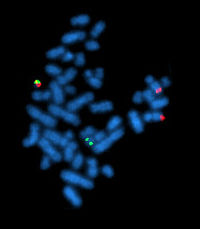
Photo from wikipedia
Several studies have compared the molecular responses between e14a2 and e13a2 BCR::ABL1 transcripts in chronic myeloid leukemia (CML) patients treated with front‐line imatinib, but there were very limited studies on… Click to show full abstract
Several studies have compared the molecular responses between e14a2 and e13a2 BCR::ABL1 transcripts in chronic myeloid leukemia (CML) patients treated with front‐line imatinib, but there were very limited studies on nilotinib or dasatinib‐treated patients. We retrospectively analyzed the molecular responses in 1124 CML patients with the e14a2 or e13a2 transcript receiving front‐line imatinib, nilotinib or dasatinib treatment. Patients with the e14a2 transcript had higher optimal response rates than those with the e13a2 transcript at 12 months in the imatinib‐treated group, and 6 and 12 months in the nilotinib‐treated group. The optimal response rates were not significantly different between the two transcripts in the dasatinib‐treated group at landmark molecular responses. With a median follow‐up time of 48.4 months, higher cumulative incidences of BCR::ABL1 International Scale ≤1% and major molecular response were observed in patients with the e14a2 rather than the e13a2 transcript receiving front‐line imatinib or nilotinib treatment, but not in dasatinib‐treated patients. The progression‐free survival and overall survival did not differ between the two transcripts in all three treatment groups. In view of the speed and depth of molecular responses, BCR::ABL1 transcript subtypes might provide helpful information in selecting a front‐line tyrosine kinase inhibitor for individual young patients with future potential treatment‐free remission.
Journal Title: Cancer Science
Year Published: 2022
Link to full text (if available)
Share on Social Media: Sign Up to like & get
recommendations!